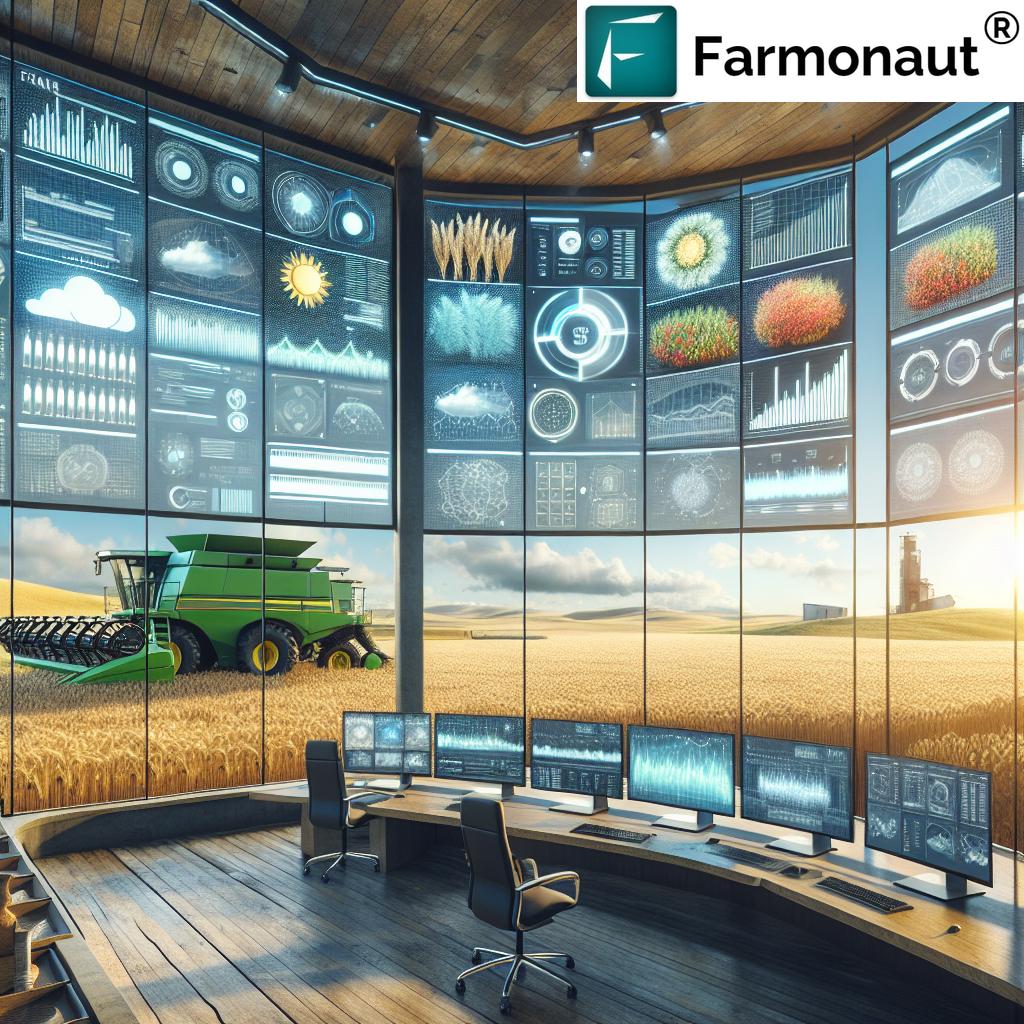Revolutionizing Alberta’s Farms: Precision Agriculture Technology for Sustainable Crop Yield Optimization
“Alberta farmers using precision agriculture technology have seen up to 20% increase in crop yields over traditional methods.”
Welcome to the cutting edge of farming in Alberta! We’re excited to take you on a journey through the latest innovations in precision agriculture technology and sustainable farming practices that are transforming our province’s agricultural landscape. As we dive into this comprehensive exploration, we’ll uncover how modern farmers are leveraging advanced tools and techniques to optimize crop yields while promoting environmental stewardship.
The Dawn of Precision Agriculture in Alberta
Alberta’s farming community has always been known for its resilience and innovation. Today, we’re witnessing a revolution in the way we approach agriculture, with precision technology leading the charge. This shift is not just about increasing productivity; it’s about creating a sustainable future for our farms and our planet.
Precision agriculture technology encompasses a wide range of tools and methods that allow farmers to make more informed decisions about their crops. From satellite imagery analysis to AI-powered weather forecasting, these technologies are helping us optimize every aspect of crop production.

Key Technologies Transforming Alberta’s Farms
- Satellite Imagery Analysis: Companies like Farmonaut are at the forefront of this technology, providing farmers with real-time data on crop health, soil moisture, and more.
- Drone-based Crop Monitoring: Offering a bird’s-eye view of fields, drones help identify issues before they become serious problems.
- IoT Soil Sensors: These devices provide continuous data on soil conditions, enabling precise irrigation and fertilization.
- AI-powered Weather Forecasting: Advanced algorithms predict weather patterns with unprecedented accuracy, allowing farmers to plan accordingly.
- Variable Rate Application Systems: These systems optimize the use of inputs like fertilizers and pesticides, reducing waste and environmental impact.
- Automated Irrigation Systems: Smart irrigation technology ensures crops receive exactly the right amount of water, conserving this precious resource.
Let’s take a closer look at how these technologies compare in terms of their impact on sustainable crop yield optimization:
| Technology | Primary Function | Estimated Crop Yield Increase (%) | Sustainability Impact | Implementation Complexity | Estimated Cost Range ($) |
|---|---|---|---|---|---|
| Satellite Imagery Analysis | Crop health monitoring | 10-15% | High | Low | 5,000-15,000 |
| Drone-based Crop Monitoring | Detailed field assessment | 8-12% | Medium | Medium | 2,000-10,000 |
| IoT Soil Sensors | Real-time soil data collection | 5-10% | High | Low | 1,000-5,000 |
| AI-powered Weather Forecasting | Accurate weather prediction | 7-12% | Medium | Low | 500-3,000 |
| Variable Rate Application Systems | Optimized input application | 10-20% | High | High | 10,000-50,000 |
| Automated Irrigation Systems | Precision water management | 15-25% | High | Medium | 5,000-20,000 |
As we can see from this comparison, each technology offers unique benefits in terms of crop yield increase and sustainability impact. The choice of which technologies to implement often depends on the specific needs of the farm, budget constraints, and the farmer’s comfort with technology adoption.
Sustainable Farming Practices: The Heart of Modern Agriculture
While technology plays a crucial role in optimizing crop yields, it’s equally important to focus on sustainable farming practices. These practices not only help protect our environment but also ensure the long-term viability of our farms.
- Crop Rotation: This age-old practice helps maintain soil health and reduce pest problems.
- Cover Cropping: Planting cover crops between growing seasons protects soil from erosion and adds nutrients.
- Reduced Tillage: Minimizing soil disturbance helps preserve soil structure and beneficial organisms.
- Integrated Pest Management: This approach combines biological, cultural, and chemical tools to manage pests effectively while minimizing environmental impact.
By combining these sustainable practices with precision agriculture technology, Alberta’s farmers are setting new standards for efficiency and environmental stewardship.
Weather Forecasting: A Farmer’s Best Friend
In Alberta’s diverse climate, accurate weather forecasting is crucial for successful farming. Advanced weather forecasting tools, often integrated with precision agriculture platforms, provide farmers with detailed, localized predictions. This information allows for better planning of planting, harvesting, and other critical farm activities.
Farmonaut’s platform, for instance, incorporates weather data into its crop monitoring system, offering farmers a comprehensive view of their fields’ conditions and upcoming weather patterns. This integration of data sources is a hallmark of modern precision agriculture.
Agricultural Market Trends: Staying Ahead of the Curve
Understanding market trends is essential for Alberta’s farmers to make informed decisions about crop selection and production strategies. Some key trends we’re seeing include:
- Increased demand for organic produce
- Growing interest in plant-based proteins
- Rising importance of traceability in food supply chains
- Emerging markets for specialty crops
Precision agriculture technology can help farmers adapt to these trends by providing data-driven insights into crop performance and market demands.
Innovative Grain Storage Solutions
Proper grain storage is crucial for maintaining crop quality and maximizing profits. Alberta’s farmers are adopting cutting-edge storage solutions that incorporate technology for monitoring and maintaining optimal conditions. These innovations include:
- Smart silos with integrated sensors for temperature and moisture control
- Automated aeration systems that respond to weather conditions
- Mobile apps for remote monitoring of grain storage conditions
These technologies help reduce post-harvest losses and ensure that Alberta’s grains meet the highest quality standards for both domestic and international markets.
Winter Crop Varieties: Extending the Growing Season
Alberta’s farmers are increasingly turning to winter crop varieties to make the most of our short growing season. These crops, planted in the fall and harvested the following summer, offer several advantages:
- Better utilization of soil moisture
- Reduced soil erosion
- Earlier harvest, allowing for better market timing
- Improved crop rotation options
Precision agriculture technology plays a crucial role in managing winter crops, providing valuable data on soil conditions, crop development, and winter survival rates.

Spotlight on Young Farmers: Driving Innovation
“Young Canadian farmers have reduced water usage by 30% through innovative digital farming tools and sustainable practices.”
Alberta’s young farmers are at the forefront of adopting new technologies and sustainable practices. These innovative agriculturists are:
- Embracing digital tools for farm management
- Experimenting with new crop varieties
- Implementing advanced irrigation techniques
- Exploring direct-to-consumer marketing strategies
Their enthusiasm for technology and sustainability is helping to shape the future of farming in our province.
Agricultural Machinery Innovations
The machinery used on Alberta’s farms is becoming increasingly sophisticated, with a focus on efficiency and precision. Some notable innovations include:
- GPS-guided tractors and harvesters for ultra-precise field operations
- Robotic weeders that reduce the need for herbicides
- Smart sprayers that apply pesticides only where needed
- Autonomous vehicles for various farm tasks
These advanced machines work in tandem with precision agriculture technology to optimize every aspect of crop production.
Livestock Systems: Integrating with Crop Production
While our focus has been on crop production, it’s important to note that many Alberta farms integrate livestock systems into their operations. Precision agriculture technology is making its way into livestock management as well, with innovations such as:
- Wearable devices for animal health monitoring
- Automated feeding systems
- Precision grazing management tools
These technologies help farmers optimize their livestock operations while also managing the interactions between livestock and crop production systems.
Challenges and Opportunities in Alberta’s Agricultural Sector
While the future of farming in Alberta looks bright, there are still challenges to overcome:
- Climate change impacts: Adapting to changing weather patterns and increased frequency of extreme weather events
- Water scarcity: Developing more efficient irrigation systems and drought-resistant crops
- Market volatility: Navigating fluctuating commodity prices and trade uncertainties
- Technology adoption barriers: Addressing the learning curve and initial investment costs associated with new technologies
However, these challenges also present opportunities for innovation and growth. By leveraging precision agriculture technology and sustainable practices, Alberta’s farmers are well-positioned to tackle these issues head-on.
The Role of Farmonaut in Alberta’s Agricultural Future
As we look to the future of farming in Alberta, companies like Farmonaut are playing a crucial role in driving innovation and sustainability. Farmonaut’s satellite-based farm management solutions offer valuable tools for farmers looking to optimize their operations:
- Real-time crop health monitoring using satellite imagery
- AI-based advisory systems for personalized farm management
- Weather forecasting integrated with crop data
- Resource management tools for efficient farm operations
By making these advanced technologies accessible and affordable, Farmonaut is helping to level the playing field for farmers of all sizes across Alberta.
Explore Farmonaut’s solutions:
The Future of Farming in Alberta
As we look ahead, the future of farming in Alberta is bright and full of potential. The integration of precision agriculture technology, sustainable practices, and innovative approaches to crop and livestock management is setting the stage for a more productive and environmentally friendly agricultural sector.
We anticipate seeing:
- Increased adoption of AI and machine learning in farm management
- Greater integration of data across the entire agricultural supply chain
- Development of new crop varieties tailored to Alberta’s changing climate
- Expansion of vertical farming and controlled environment agriculture
By embracing these innovations and continuing to prioritize sustainability, Alberta’s farmers will be well-equipped to meet the challenges of feeding a growing population while preserving our precious natural resources.
Conclusion: A New Era for Alberta’s Farms
The revolution in precision agriculture technology and sustainable farming practices is transforming Alberta’s agricultural landscape. From satellite-guided tractors to AI-powered crop monitoring, these innovations are helping our farmers produce more food with fewer resources while minimizing environmental impact.
As we’ve explored in this comprehensive overview, the integration of technology, sustainable practices, and innovative approaches to crop and livestock management is setting the stage for a more productive and environmentally friendly agricultural sector in Alberta.
By embracing these advancements and continuing to prioritize sustainability, Alberta’s farmers are not just adapting to change – they’re leading the way into a new era of smart, efficient, and sustainable agriculture. The future of farming in our province is bright, and we’re excited to see what new innovations and achievements lie ahead.
FAQ Section
Q: What is precision agriculture technology?
A: Precision agriculture technology refers to a suite of tools and methods that use data and advanced technologies to optimize crop production. This includes satellite imagery, GPS-guided machinery, IoT sensors, and AI-powered analytics to make farming more efficient and sustainable.
Q: How does precision agriculture benefit farmers in Alberta?
A: Precision agriculture helps Alberta farmers by providing detailed, real-time information about their crops and fields. This allows for more precise application of inputs like water and fertilizer, better pest management, and improved decision-making overall, leading to increased yields and reduced environmental impact.
Q: What are some sustainable farming practices used in Alberta?
A: Sustainable farming practices in Alberta include crop rotation, cover cropping, reduced tillage, integrated pest management, and precision irrigation. These practices help maintain soil health, reduce erosion, conserve water, and minimize the use of chemicals.
Q: How are young farmers in Alberta driving innovation in agriculture?
A: Young farmers in Alberta are at the forefront of adopting new technologies and sustainable practices. They are embracing digital tools for farm management, experimenting with new crop varieties, implementing advanced irrigation techniques, and exploring direct-to-consumer marketing strategies.
Q: What role does weather forecasting play in modern farming?
A: Accurate weather forecasting is crucial for modern farming, especially in Alberta’s diverse climate. Advanced forecasting tools help farmers plan planting, harvesting, and other critical activities. Many precision agriculture platforms, like Farmonaut, integrate weather data with crop monitoring systems for comprehensive farm management.
For more information on Farmonaut’s precision agriculture solutions, visit our web app or check out our API Developer Docs.






